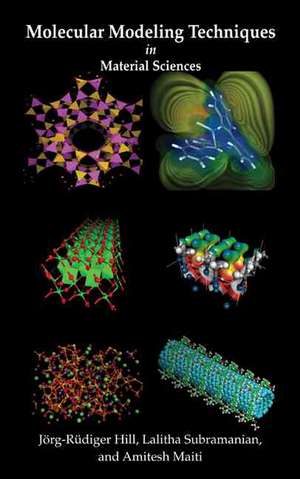Molecular Modeling Techniques In Material Sciences
Autor Jörg-Rüdiger Hill, Lalitha Subramanian, Amitesh Maitien Limba Engleză Hardback – 30 mar 2005
Molecular Modeling Techniques in Materials Science presents the background and tools for chemists and physicists to perform in-silico experiments to understand relationships between the properties of materials and the underlying atomic structure. These insights result in more accurate data for designing application-specific materials that withstand real process conditions, including hot temperatures and high pressures.
Preț: 511.76 lei
Preț vechi: 602.07 lei
-15% Nou
Puncte Express: 768
Preț estimativ în valută:
97.94€ • 101.87$ • 80.85£
97.94€ • 101.87$ • 80.85£
Carte tipărită la comandă
Livrare economică 14-28 aprilie
Preluare comenzi: 021 569.72.76
Specificații
ISBN-13: 9780824724191
ISBN-10: 0824724194
Pagini: 328
Ilustrații: 50 equations; 32 Tables, black and white; 50 Illustrations, black and white
Dimensiuni: 156 x 234 x 21 mm
Greutate: 0.77 kg
Ediția:1
Editura: CRC Press
Colecția CRC Press
ISBN-10: 0824724194
Pagini: 328
Ilustrații: 50 equations; 32 Tables, black and white; 50 Illustrations, black and white
Dimensiuni: 156 x 234 x 21 mm
Greutate: 0.77 kg
Ediția:1
Editura: CRC Press
Colecția CRC Press
Public țintă
UndergraduateCuprins
Scope of Materials Modeling. Introduction. Theoretical Methods. Getting Started on a Modeling Project. General Structure of Molecular Modeling Programs. Computer Hardware. Software Related to Materials Modeling. Metal Oxides. Introduction. Electronic Structure Methods. Force Field Methods. Microporous Materials. Introduction. Ab Initio and Density Functional Methods. Force Field Calculations. A Case Study — Methanol Adsorption on Bridging Hydroxyl Groups. Glass. Introduction. Simulation of Silica Glass. Alkali Silicate Glasses. Aluminosilicate, Borosilicate and Other Glasses. Simulation of Glass Surface and Diffusion. Calculation of Glass Properties. Semiconductors and Superconductors. Semiconductors. Superconductors. Nanomaterials. Introduction. Carbon Nanotubes (CNTs). Nanowires and Nanoribbons. Theoretical Background. Quantum Chemistry. Vibrational Spectra. Statistical Mechanics. Molecular Mechanics. Combining Quantum Mechanics and Force Fields — Embedding. Monte Carlo Calculations. Molecular Dynamics Calculations. Grand Canonical Molecular Dynamics. Appendix. Common Abbreviations in Computational Chemistry. Basis Set Naming Conventions. Atomic Units. References. Index.
Scope of Materials Modeling - Metal Oxides - Microporous Materials - Semiconductors and Superconductors – Nanomaterials - Theoretical Background
Recenzii
“…A timely addition to the growing literature on molecular-level modeling of materials. … Especially useful to researchers doing molecular modeling … Nicely organized for readers who want to focus in quickly on a topic of interest. … a welcome and useful addition to university and industrial libraries. ...”
—Randall Q. Snurr in Wiley Angewandte Chemie, March 2005
“… Defines an extremely wide scope. A variety of topics, including (heterogeneous) catalysis...materials synthesis...the determination of properties...as well as a large number of different simulation methods. … A large number of up-to-date references allow readers to dig deeper. … Overall, this is a nice book especially for materials scientists...interested in the potential of current modeling techniques. …”
—Dr. Rochus Schmid, Lehrstuhl fur Anorganische Chemie II Ruhr-Universitat Bochum, Germany, in Chemphyshem, 2006
“...Books specifically oriented towards the selection of the appropriate modeling approach for a problem at hand are rare. … This outstanding text contains a wealth of useful information that has great utility and practical value for any practitioner in the field of material modeling. The authors have done a very good job in presenting a rich body of up-to-date, but not overwhelming, information … a worthwhile addition to any library and can be recommended for all chemists, chemical engineers and materials scientists interested in the design of materials having targeted properties. ”
—Professor Marie-Francoise Reyniers, Chemical Engineering Department, Ghent University, Belgium, in Chemical Engineering Research and Design, 2006, 84(A5): 416-417
“… defines an extremely wide scope. A variety of topics, including (heterogeneous) catalysis, any kind of materials synthesis, as well as the determination of properties of bulk and surface or nanosized systems could be included as well as a large number of different simulation methods. … A large number of up-to-date references allow to dig deeper. … Overall, this is a nice book especially for materials scientists (from industrial R&D departments) who are interested in the potential of current modeling techniques. …”
—Dr. Rochus Schmid, Lehrstuhl fur Anorganische Chemie II Ruhr-Universitat Bochum, Germany, in Chemphyshem, 2006
“Several books on molecular modeling have appeared in the last decade, but books specifically oriented towards the selection of the appropriate modeling approach for a problem at hand are rare. The authors’ incentive for writing the book is to promote the applications of molecular modeling techniques to industrial problems. … The book focuses on providing information on the various methods used in atomistic micro-scale modeling of a wide variety of materials such as oxides, microporous materials, glasses, super- and semiconductors and nanomaterials. … this outstanding text contains a wealth of useful information that has great utility and practical value for any practitioner in the field of material modeling. The authors have done a very good job in presenting a rich body of up-to-date, but not overwhelming, information on methods ranging from quantum chemical calculation of the electronic structure of molecules to classical mechanical simulation of the dynamical properties of many atom systems. … An extensive list of references is given at the end of the book. Throughout the book, the reader will find illustrations to supplement the text. … In summary, the book is a worthwhile addition to any library and can be recommended for all chemists, chemical engineers and materials scientists interested in the design of materials having targeted properties. ”
—Professor Marie-Francoise Reyniers, Chemical Engineering Department, Ghent University, Belgium, in Chemical Engineering Research and Design, 2006, 84(A5): 416-417
n extremely wide scope. A variety of topics, including (heterogeneous) catalysis, any kind of materials synthesis, as well as the determination of properties of bulk and surface or nanosized systems could be included as well as a large number of different simulation methods. … A large number of up-to-date references allow to dig deeper. … Overall, this is a nice book especially for materials scientists (from industrial R&D departments) who are interested in the potential of current modeling techniques. …”
—Dr. Rochus Schmid, Lehrstuhl fur Anorganische Chemie II Ruhr-Universitat Bochum, Germany, in Chemphyshem, 2006
“Several books on molecular modeling have appeared in the last decade, but books specifically oriented towards the selection of the appropriate modeling approach for a problem at hand are rare. The authors’ incentive for writing the book is to promote the applications of molecular modeling techniques to industrial problems. … The book focuses on providing information on the various methods used in atomistic micro-scale modeling of a wide variety of materials such as oxides, microporous materials, glasses, super- and semiconductors and nanomaterials. … this outstanding text contains a wealth of useful information that has great utility and practical value for any practitioner in the field of material modeling. The authors have done a very good job in presenting a rich body of up-to-date, but not overwhelming, information on methods ranging from quantum chemical calculation of the electronic structure of molecules to classical mechanical simulation of the dynamical properties of many atom systems. … An extensive list of references is given at the end of the book. Throughout the book, the reader will find illustrations to supplement the text. … In summary, the book is a worthwhile addition to any library and can be recommended for all chemists, chemical engineers and materials scientists interested in the design of materials having targeted properties. ”
—Professor Marie-Francoise Reyniers, Chemical Engineering Department, Ghent University, Belgium, in Chemical Engineering Research and Design, 2006, 84(A5): 416-417
—Randall Q. Snurr in Wiley Angewandte Chemie, March 2005
“… Defines an extremely wide scope. A variety of topics, including (heterogeneous) catalysis...materials synthesis...the determination of properties...as well as a large number of different simulation methods. … A large number of up-to-date references allow readers to dig deeper. … Overall, this is a nice book especially for materials scientists...interested in the potential of current modeling techniques. …”
—Dr. Rochus Schmid, Lehrstuhl fur Anorganische Chemie II Ruhr-Universitat Bochum, Germany, in Chemphyshem, 2006
“...Books specifically oriented towards the selection of the appropriate modeling approach for a problem at hand are rare. … This outstanding text contains a wealth of useful information that has great utility and practical value for any practitioner in the field of material modeling. The authors have done a very good job in presenting a rich body of up-to-date, but not overwhelming, information … a worthwhile addition to any library and can be recommended for all chemists, chemical engineers and materials scientists interested in the design of materials having targeted properties. ”
—Professor Marie-Francoise Reyniers, Chemical Engineering Department, Ghent University, Belgium, in Chemical Engineering Research and Design, 2006, 84(A5): 416-417
“… defines an extremely wide scope. A variety of topics, including (heterogeneous) catalysis, any kind of materials synthesis, as well as the determination of properties of bulk and surface or nanosized systems could be included as well as a large number of different simulation methods. … A large number of up-to-date references allow to dig deeper. … Overall, this is a nice book especially for materials scientists (from industrial R&D departments) who are interested in the potential of current modeling techniques. …”
—Dr. Rochus Schmid, Lehrstuhl fur Anorganische Chemie II Ruhr-Universitat Bochum, Germany, in Chemphyshem, 2006
“Several books on molecular modeling have appeared in the last decade, but books specifically oriented towards the selection of the appropriate modeling approach for a problem at hand are rare. The authors’ incentive for writing the book is to promote the applications of molecular modeling techniques to industrial problems. … The book focuses on providing information on the various methods used in atomistic micro-scale modeling of a wide variety of materials such as oxides, microporous materials, glasses, super- and semiconductors and nanomaterials. … this outstanding text contains a wealth of useful information that has great utility and practical value for any practitioner in the field of material modeling. The authors have done a very good job in presenting a rich body of up-to-date, but not overwhelming, information on methods ranging from quantum chemical calculation of the electronic structure of molecules to classical mechanical simulation of the dynamical properties of many atom systems. … An extensive list of references is given at the end of the book. Throughout the book, the reader will find illustrations to supplement the text. … In summary, the book is a worthwhile addition to any library and can be recommended for all chemists, chemical engineers and materials scientists interested in the design of materials having targeted properties. ”
—Professor Marie-Francoise Reyniers, Chemical Engineering Department, Ghent University, Belgium, in Chemical Engineering Research and Design, 2006, 84(A5): 416-417
n extremely wide scope. A variety of topics, including (heterogeneous) catalysis, any kind of materials synthesis, as well as the determination of properties of bulk and surface or nanosized systems could be included as well as a large number of different simulation methods. … A large number of up-to-date references allow to dig deeper. … Overall, this is a nice book especially for materials scientists (from industrial R&D departments) who are interested in the potential of current modeling techniques. …”
—Dr. Rochus Schmid, Lehrstuhl fur Anorganische Chemie II Ruhr-Universitat Bochum, Germany, in Chemphyshem, 2006
“Several books on molecular modeling have appeared in the last decade, but books specifically oriented towards the selection of the appropriate modeling approach for a problem at hand are rare. The authors’ incentive for writing the book is to promote the applications of molecular modeling techniques to industrial problems. … The book focuses on providing information on the various methods used in atomistic micro-scale modeling of a wide variety of materials such as oxides, microporous materials, glasses, super- and semiconductors and nanomaterials. … this outstanding text contains a wealth of useful information that has great utility and practical value for any practitioner in the field of material modeling. The authors have done a very good job in presenting a rich body of up-to-date, but not overwhelming, information on methods ranging from quantum chemical calculation of the electronic structure of molecules to classical mechanical simulation of the dynamical properties of many atom systems. … An extensive list of references is given at the end of the book. Throughout the book, the reader will find illustrations to supplement the text. … In summary, the book is a worthwhile addition to any library and can be recommended for all chemists, chemical engineers and materials scientists interested in the design of materials having targeted properties. ”
—Professor Marie-Francoise Reyniers, Chemical Engineering Department, Ghent University, Belgium, in Chemical Engineering Research and Design, 2006, 84(A5): 416-417
Notă biografică
Jörg-Rüdiger Hill, Lalitha Subramanian, Amitesh Maiti
Descriere
This book explores the use of molecular modeling and simulation for designing application-specific materials that withstand real process conditions. The authors develop a framework for identifying objectives, defining design parameters, and other requirements for planning a modeling project. They present key information on how to handle different materials, including oxides, superconductors, semiconductors, zeolites, glass, and nanomaterials. They further integrate proven methods and computation tools, new advances in theoretical techniques and numerical algorithms, and techniques expected to become generally available in the near future.



















